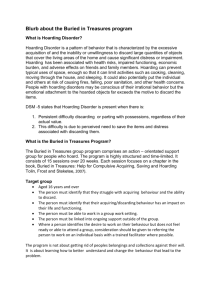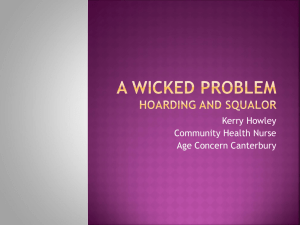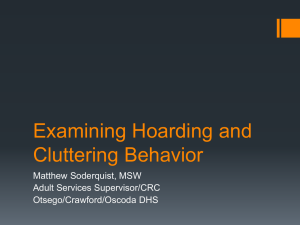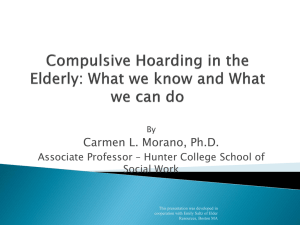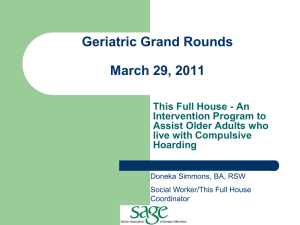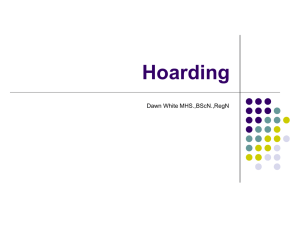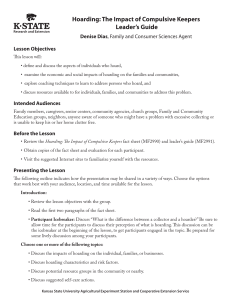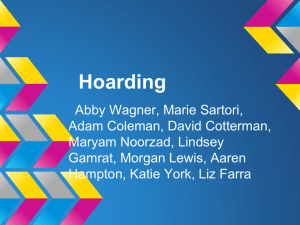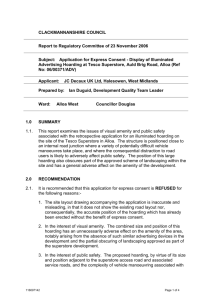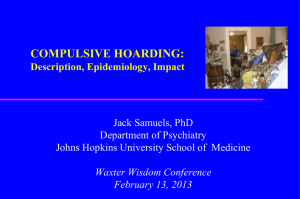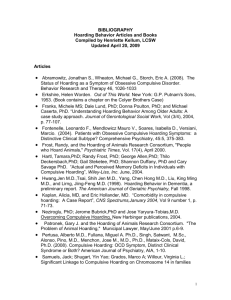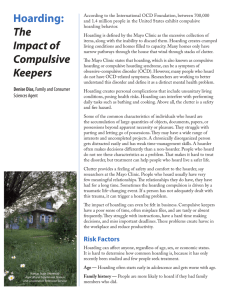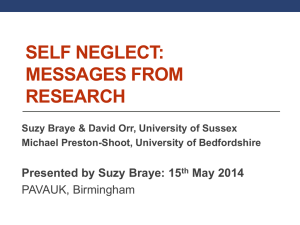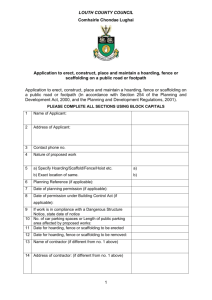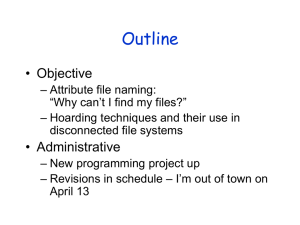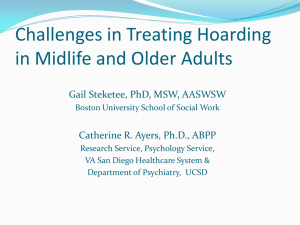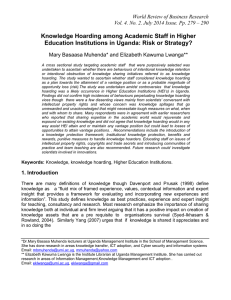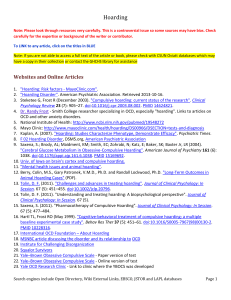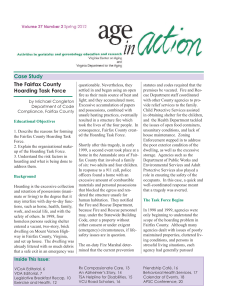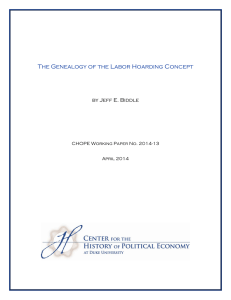Hoarding in the Elderly
advertisement
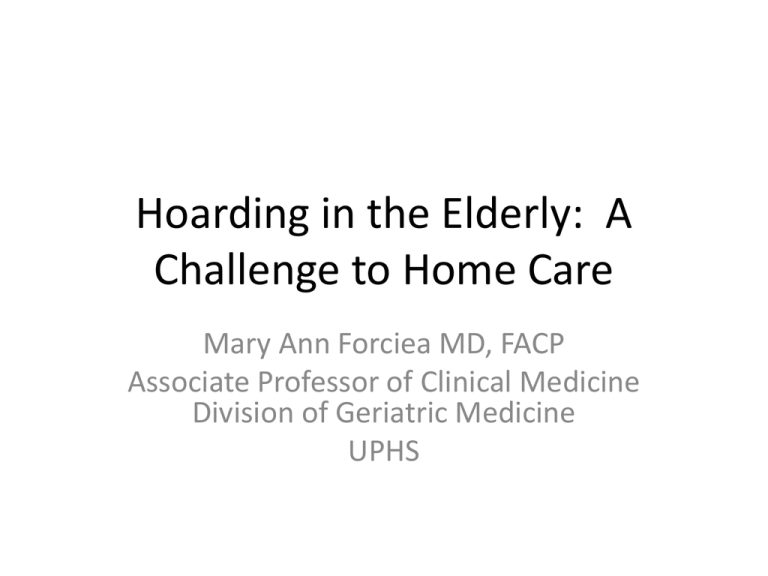
Hoarding in the Elderly: A Challenge to Home Care Mary Ann Forciea MD, FACP Associate Professor of Clinical Medicine Division of Geriatric Medicine UPHS Why am I (or my team) here? • This is a common and frustrating problem for us • Hoping to learn some diagnostic tips • Hoping to learn some management tips • Want a chance to vent frustration at the system of care available to these patients. • Like to see my colleagues. • Always wanted to try this restaurant Why am I (or my team) here? 1. 2. 3. 4. 5. This is a challenging problem for us Want a chance to vent about these patients Like to see my colleagues Always wanted to try this restaurant Want to see if UPHS has any better ideas than we do 20% 1 20% 2 20% 20% 3 4 20% 5 Key questions for this seminar • Is hoarding in older patients different than in younger patients • What are the critical clinical questions in the evaluation of patients with hoarding? • What treatment strategies can be attempted? • What resources are available in the Delaware Valley? Case- DR • 78 yr old lady, widow with 2 children • Living in Senior housing • Call from facility SW (Friday at 4PM) – Increasing complaints from neighbors about ‘cleanliness’ of apartment – Apartment visit that day • Toilet overflow, clutter, attire – Home health aide refusing to return – Facility considering eviction Case continues 2 • >40 yr history of bipolar disorder – Has medications – Multiple barriers to ongoing psychiatric care • Diabetes mellitus with peripheral neuropathy] • Venous stasis • DJD of knees, hips, LS spine – increasing immobility Case 3 – prior history • Third dwelling while part of our primary care program (8 yrs) • ‘Clutter’ an issue in each site – Mania associated with requests for DME • Progressive mobility dependence – Third move precipitated by loss of driving privileges Added information • Visited patient one week ago • Called patient after SW call – Admits to overwhelming apartment ‘situation’ – Blame exclusively on building management – Admits to progressive URI over past week – Reluctant to agree to ED or hospital visit • Home care team urgent conference call Living room (close to hers –google images) Bedroom (close to hers – google images) Options 1. 2. 3. 4. Sign out to weekend covering partner Temporize by offering a Monday medical house call visit by your team Arrange transport to ED for evaluation Directly admit to your inpatient service 25% 1 25% 25% 2 3 25% 4 Hoarding – Definition Saxena 2007 • Collecting – excessive quantities of – Poorly useable items – Of little value • Failing to discard items • Interference with function Excessive acquisition • Buying • Accumulation of ‘free’ things – Received – Sought out (dumpster diving • Motivation – “thrill” – ‘therapy’ for unpleasant feelings (?‘retail’ therapy) – Fear of missed opportunities Failure to discard • Most easily recognized • Motivation – Sentimental value – Wasteful to discard – Might be useful in the future • Decreased ability to group/sort items • Poor organizational skills Interference with function • Clutter – cannot use space or object for its intended purpose • Functional status – cannot walk through apartment, bathe, cook\ • Consequences – Eviction, health concerns, fire risks Risks of hoarding • • • • • Social dysfunction Functional disability Falls Fires Unsanitary conditions Is hoarding a psychiatric disorder? • Associations: – OCD – Schizophrenia – Dementia (especially fronto-temporal) – Mood Disorders • Not currently listed in DSM-IV, will likely be listed in DSM-V • Little attention to older patients with hoarding behaviors FTD vs AD Miller et al Neurology 1997 Symptom Insidious onset Early loss of personal & social awareness hyperorality Perseverative behavior Emotional unconcern Progressive reduction in speech Stereotypy of speech Praxis FTD +/30 29 22 22 19 24 24 20 29 AD +/30 30 1 0 1 6 0 2 5 NS <0.0001 “ “ “ “ “ “ Natural history of hoarding • Chronic problem with gradual worsening across lifespan – 80% of patients report symptoms by age 18 • Late onset patients more often have a stressful life event at initiation • Familial component – 85% of hoarders describe a 1st degree relative as a ‘packrat’ Distinctions in Older Patients with ‘Terrible Decline” • Hoarding versus self care deficit? – Or both • Long term or acute? • Decisional capacity? • Severe enough to warrant coercive action? Assessment tools Clutter Hoarding Scale Institute for Challenging Disorganization In treating these patients, we have tried: 1. SSRIs 2. Cholinesterase Inhibitors 3. Cognitive/behaviro al therapy 4. Occupational therapy consultation 25% 1 25% 25% 2 3 25% 4 I have been satisfied with the outcomes of my therapy 1. Yes 2. No 50% 1 50% 2 My patients have been happy with the outcomes of therapy 1. Yes 2. No 50% 1 50% 2 Treatment • Medications – SSRI – possibly less effective in older patients • Cognitive behavioral therapy – Information processing deficits • Help sort into larger clusters – Maladaptive beliefs • I am a craftsman because I own tools – Attachment to possessions • Sentiment, control • Interprofessional team management Self care deficit “The result of an adult’s inability due to diminished capacity to perform essential self-care tasks such as providing essential food, clothing, shelter, and medical care; obtaining goods and services necessary to maintain physical health, mental health, emotional well-being and general safety; and/or manage financial affairs.” -APS Self-Neglect – Definition Pavlou and Lachs JGIM 2008 • A Self-neglector is a person who exhibits 1 or more of the following: – 1) persistent inattention to personal hygiene and/or environment – 2) repeated refusal of some/all indicated services which can reasonably be expected to improve quality of life – 3) self endangerment through the manifestation of unsafe behaviors (e.g. persistent refusal to care for a wound, creating fire hazards in the home) Self-neglect • • • • • Annual incidence: 5.2 per 1000 elders Self-neglect 50-75% of elder mistreatment 90% of all self-neglect APS ≥ 65y/o ♀>♂ Decreased survival 40.3% died within 13 years follow-up • Self-neglect patients more likely to die in NH Lachs et al. JAMA 1998 Clinical evaluation • Dementia • Depression • If acute, look for medical problem – Stroke, infection, medication effect • Determination of decisional capacity Treatment • Often emergency-related – Hip fracture, pneumonia, police incident • If incapable of decisions – Refer for competency determination and guardianship • Placement likely • If capable – Inform of helpful services – Documentation of preferences for Advance Directive Assessment tools Self neglect severity scale -Houston Geriatrics group Personal appearance of subject Hair Nails House Home Environment Bathroom Self Neglect Severity Scale Decisional capacity • Competence – a legal determination in court – Appointment of a guardian • Of the person (medical decisions) • Of finances • Decisional capacity – a clinical decision – Decision specific – “Hierachies” of decisions • Most basic decisions honored even in presence of some impairment • May make ‘low stakes’ decisions even if unable to make ‘high stakes’ decisions Elements of Decision Making • Ability to communicate a choice • Ability to understand and retain relevant information • Ability to appreciate the situation and consequences for oneself • Ability to manipulate information rationally Ability to appreciate situation for oneself • Acknowledge that condition is present • Realizes that risks and benefits apply to him/her • May involve understanding of motives for choices • What will happen if you refuse treatment? If you accept? Manipulates information rationally • Reaches conclusions that are logically consistent with starting premises • Again, may involve description of motives • Please help me to understand why you decided to accept/refuse treatment Summary • Older patients with hoarding behaviors have higher likelihood of co-existing dementia – Time course of progression is critical information • Hoarding and self neglect frequently co-exist in older patients – Assessment tools can help guide team planning and follow-up • The determination of decisional capacity is often critical • Local regulation about safety standards is important in action steps The Eye of the Beholder Resources/References • The Institute for Challenging Disorganization: – www.challengingdisorganization.org • Valente, Sharon. The Hoarding Syndrome. Home Health Care Nurse 27:432. 2009 – WWW.homehealthcarenurseonline.com • Guilliam, CM and Tolin, DF. Compulsive Hoarding. Bulletin of the Menniger Clinic 74:93. 2010. • Dyer, CB et al. Self-neglect among the elderly; Am J of Public Health 97:1671.2007
